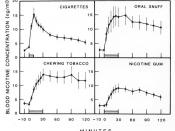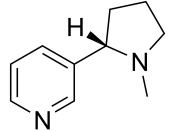Stimulants are a class of drugs that elevate mood, increase feelings of well-being, and increase energy and alertness. Stimulants often produce a feeling of euphoria as well as a state of immense relaxation in users. Examples of stimulants include cocaine, crack cocaine, amphetamines, Methamphetamine, methylphenidate (Ritalin), nicotine, and MDMA (3-4 methylenedioxyMethamphetamine, better known as Ecstasy). (nida)Nicotine is the drug contained in tobacco leaves. Whether someone smokes, chews, or sniffs tobacco, he or she is delivering nicotine to the brain. Every cigarette contains about 10 milligrams of nicotine and it is the addictive properties of nicotine that keep people smoking despite its harmful effects.
Tobacco, a plant indigenous to North and South American has been found to have been used as far back as 1 B.C., and was used primarily for medicinal and ritual purposes. In 1492, Columbus received the dried leaves as a gift from the Native American peoples and from this moment tobacco traveled and made its way to Europe (udayton).
From this point up until the early 1960's this powerful stimulant has been touted as a way toward better health, creator of a glamorous lifestyle and the path to a happier future. Those of us fortunate enough to be living in modern times are aware of quite the opposite.
The powerful drug contained in the tobacco plant is called nicotine. When tobacco is smoked, nicotine is absorbed by the lungs and quickly moved into the bloodstream. Within eight seconds, it reaches the brain where its powerful effects are felt. Nicotine can also enter the bloodstream through the mucous membranes that line the mouth (if tobacco is chewed) or nose (if snuff is used), and even through the skin, a process that has been proven fatal for many who harvest and prepare tobacco leaves.
Nicotine, in addition...


